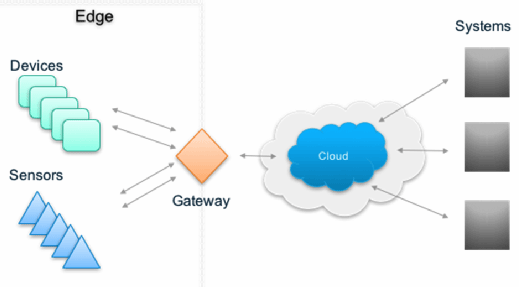
Sergey Nivens - Fotolia
Using an IoT gateway to connect the 'things' to the cloud
There's one device that is key to tying internet of things systems together: the IoT gateway. Read on to learn the benefits and applications of an IoT edge gateway.
As IoT grows and billions of connected devices enter the world, one of the most critical components of future internet of things systems may be a device known as an IoT gateway. An IoT gateway aggregates sensor data, translates between sensor protocols, processes sensor data before sending it onward and more.
The importance of IoT gateways is understandable when you consider the explosion in connected "things" that has occurred over the past few years. With scores of protocols, connectivity models and energy profiles and the highly dispersed nature of IoT systems, gateways are needed to manage and control these complex environments.
Consider the use case of an IoT-connected office building environment. Sensors are the IoT equivalent of our five senses. But instead of five senses, there may be hundreds or thousands of sensors with dozens of different functions, measuring temperature, light, noise, position of people and equipment, particles in the air, building systems operations, security systems, factory machines and more. But IoT is not just about sensing; it's also about controlling systems. Turning on and off lights, HVAC, networks and more can be done through connected systems.
Each of these IoT devices may use different protocols to connect -- such as Wi-Fi; Bluetooth; serial ports (for example, RS-232); Ethernet; MQ Telemetry Transport, or MQTT; Zigbee; and others. And each of them may connect to different control environments and have different models for management and security.
As connected devices, protocols and needs proliferate, having components connect individually back to the systems that need their data is not often possible. Some sensors and controllers use very low energy and don't support energy-intensive protocols like Wi-Fi or Bluetooth, and, therefore, can't connect directly. Some edge devices generate so much data that, in aggregate, the data is overwhelming and not all that valuable in its raw form.
Enter the IoT edge gateway
IoT gateways perform several critical functions such as device connectivity, protocol translation, data filtering and processing, security, updating, management and more. Newer IoT gateways also operate as platforms for application code that processes data and becomes an intelligent part of an edge device-enabled system.
IoT gateways sit at the intersection of edge systems -- connected devices, controllers and sensors -- and the cloud.

A gateway's position in the IoT ecosystem
Traditional network gateways have mostly performed protocol translation and device management functions. They were not intelligent, programmable devices that could perform in-depth and complex processing on IoT data. Today's "smart" IoT gateways -- delivered by companies such as Dell Technologies, Wind River/Intel, Nexcom and others -- are full-fledged computing platforms running modern operating systems (for example, Linux or Windows). These systems are sometimes also called intelligent gateways or edge gateways, but the line is blurring and the nonintelligent gateway market is likely to become largely irrelevant in coming years.
Next-generation IoT gateways open up huge opportunities to push processing closer to the edge, improving responsiveness and supporting new operating models. Consider the building systems use case above: A building management company may control millions of square feet of office and industrial space from a remote location using a distributed IoT network of sensors and controllers connected through the cloud. However, transmitting every routine packet of information generated by the sensors from dozens of facilities would quickly overwhelm the headquarters systems of the management company. They care about serious issues, out-of-bounds environmental conditions and other factors worthy of additional attention.
Adding new IoT edge gateways with full onboard processing would allow the gateways to filter out routine information and pass through the alerts that are worthy of attention. Going even further, these gateways can perform their own analytics and operations on the data -- such as determining that the temperature is too high in part of the building -- and can then use that insight to take independent action, such as turning on the air conditioning or opening vents.
Recent product announcements from Wind River and Dell show the direction the market is heading. Wind River (an Intel Company) ships a gateway platform -- Wind River Intelligent Device Platform XT -- as part of its Helix portfolio of IoT systems. This platform allows OEMs to build their own gateway devices that are customized for their needs.
The Dell Edge Gateway 5000 Series, announced in October 2015, is a turnkey device targeting multiple use cases for companies that don't want to build their own gateways. Dell's gateways ship with the Wind River platform, as do many other of the newer IoT gateway platforms.
Dell believes that its gateways will appeal to users in three major use cases: industrial automation, building automation and transportation. One of Dell's early clients is Eigen Innovations, a supplier of intelligent industrial vision systems. Eigen's infrared sensors detect quality problems in manufacturing and assembly operations. The data is transmitted to the Dell IoT gateway which runs a rules engine and can shut down the factory if issues are discovered. Since speed and availability are critical to its clients, the ability to process the data locally and ensure that quality issues are responded to quickly is critical to Eigen's model.
While these intelligent edge gateways are just rolling out to the market, the advantages of having a fully programmable and manageable platform closer to the IoT devices they support is clear.
Bridging the operations/IT gap
According to Wind River's Dinyar Dastoor, vice president and general manager of operating system platforms and IoT, an IoT edge gateway also serves as an important bridge between operations and IT. On the operations side -- factory, building management, etc. -- the focus is on delivering the business capability for which they are responsible, meaning getting the data from where it's created into systems that can act on it. IT, on the other hand, must be concerned with the security and integrity of the networks, the supportability of the system and how all of the pieces are managed.
"The huge problem is human beings. On the edge side you have people connected to the device itself -- OT, or operational technology," Dastoor said. "Trying to get these devices securely connected to the world is where the CIO comes in. Who is going to step into the others' shoes?"
The IoT gateway's role in security, data, analytics and more
To successfully bridge the gap between IT and OT, IoT gateways need to support the following functionality:
- Trusted connectivity and security -- ensuring the integrity of the network and system in both directions
- Protocol and data bridge -- being able to translate and transfer data among and between systems operating with different communications protocols and data formats, often requiring bidirectional communication capabilities
- Storage and analysis -- onboard application development platforms and storage to drive intelligence and decision-making closer to the edge device
- Management -- the ability to provision, update and control access of connected devices to the system as well as policy-based permissions
As IoT networks proliferate and use cases expand, the demands on IoT gateways for these capabilities will only intensify.
For example, industrial and manufacturing settings will require industrial IoT gateways that can withstand the processing and environmental demands encountered in the real world. If your gateway goes down, your whole connected system goes with it. While many aspects of an IoT edge gateway overlap with an industrial IoT-grade one, IIoT gateways often require greater processing power and strength than an IoT gateway in, for example, a smart home.
Kevin Terwilliger, commercial client advanced experience planning director at Dell, highlighted real-world needs for global support and service. At one level, an IoT device is really just a specialized form of PC with compute and storage running on a network.
"Having a focus on IT security and manageability is key," Terwilliger said. "There are two extremes: maker solutions with no service and support at the level customers expect, and real vendors like Dell."








